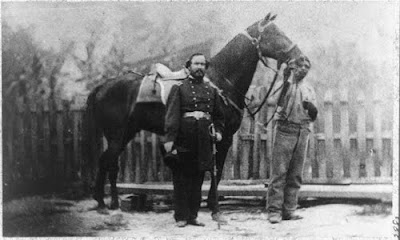As I mentioned in my
last post, I'll be self-publishing my series of Civil War horror/paranormal novels via Kindle Direct Publishing, Smashwords, and Createspace in September. The book will be available in print and ebook format for all ereaders.
Why would a professional author with eight traditionally published books and three more on the way decide to self-publish? Especially after the rants he’s published
here and
here? The simple answer is that the industry has changed and it now makes economic sense to do so. The full answer is more complex.
The publishing industry is agonizingly slow. I finished my Missouri Civil War novel,
A Fine Likeness, three years ago. I sent it off to an editor I knew at Tor. She got back to me after many months:
There is a lot of fine material here. That you can write isn’t in question. I just honestly don’t know how we would market this book--mainstream with horror elements? A quiet horror novel with a mystery wrapped around it? The economic climate these days mandate that we have projects that can go out to the widest audience and this sometimes makes it difficult to get certain books out there.I also sent it off to some agents. Some turned it down for the same reason, taking months to do so. Some never got back to me at all.
After that I submitted it to Chizine and Dorechester Publishing’s Fresh Blood Contest for unpublished horror novelists. Out of hundreds of submissions I made it into the ten finalists. There were several rounds of elimination presided over by judges from the publishing industry. I got to the top five before the contest opened up to public vote. The idea was to see how well we could market ourselves. Unfortunately, I was
traveling in Ethiopia at that time with little access to the Internet! I lost. Maybe I would have lost anyway, but being out of touch sure killed my marketing campaign.
Chizine and Dorchester both expressed interest in my novel and asked to read the whole thing. Shortly afterwards Dorchester became one of many mid-sized publishers to fall victim to the Great Recession. They laid off most of their staff and switched to ebooks only. Many industry insiders feel they’ll go under soon. They never got back to me on my submission and that’s just fine.
Chizine kept my book. I respect these guys. They publish books I love, especially the horror westerns of
Gemma Files. I waited. And waited. After fifteen months they finally got back to me:
So sorry it took us this long to get back to you. Our lives have been filled to the brim for ages! I wish I were writing with better news—especially after your long wait—but unfortunately, we're going to pass on A Fine Likeness. We dig the writing, and it's certainly in CZP's wheelhouse. The main issue, though, is that we've been publishing a similarly themed series (Gemma Files's Hexslinger series), plus we're likely taking on another one that's somewhat along these lines, so it's really just a matter of bad timing, for the most part. That said, we'd like to see something else, if you have something you think might fit for us—and we promise it won't be anywhere near 15 months to get an answer. :-) Sorry this didn't work out, Sean, but please do try us again.Cheers, and best of luck placing this elsewhere—we think you shouldn't have much trouble doing so.I’ve had enough. The Civil War Sesquicentennial has started and
now is the time to publish my series. I'm not going to wait another 15 months to have an editor tell me I have bad timing.
I started investigating the possibility of self-publishing with Kindle and liked what I saw. Setup is free and if I price my ebook at $2.99 or more I get 70% royalties minus a 15 cent “delivery fee”. Most first-time novelists get about a $5,000 advance. Some get less. Some get nothing. Doing the math I would get $1.943 per copy and I’d need to sell 2,573 copies to make $5,000.
I can do that. I’m already known for three Missouri history books and two Civil War books. I have heaps of contacts in mainstream media, the blogosphere, and twitterverse. That’s a good base on which to build a marketing campaign.
While the marketing campaign will take up a huge amount of time and effort, it’s something I would have done if I were traditionally published anyway. Most publishers do very little to market their works and authors are left to sink or swim. I will continue to traditionally publish my nonfiction because my publishers can do a better job producing and selling my books than I can.
Osprey Publishing, for example, pays me well for my military history books, does a great job on design, and they have a marketing team that actually knows how to market their product.
So for me, at this time of flux in the publishing industry, it makes sense to remain with traditional publishers for my nonfiction and strike out on my own with my fiction. I’m interested in hearing what you think about this move, and from anyone who has published with the services I'm going to use. Drop me a line in the comments section!
 When looking for cover art for my novel at the Library of Congress website I came across this fine photo. It didn't work as a cover shot but it struck me as powerful so I'm reproducing it here.
When looking for cover art for my novel at the Library of Congress website I came across this fine photo. It didn't work as a cover shot but it struck me as powerful so I'm reproducing it here.






